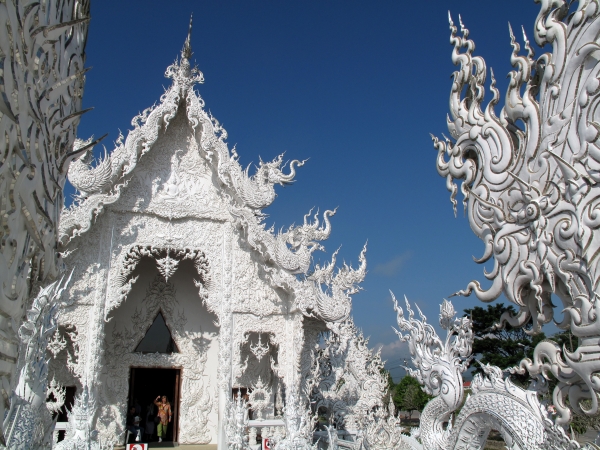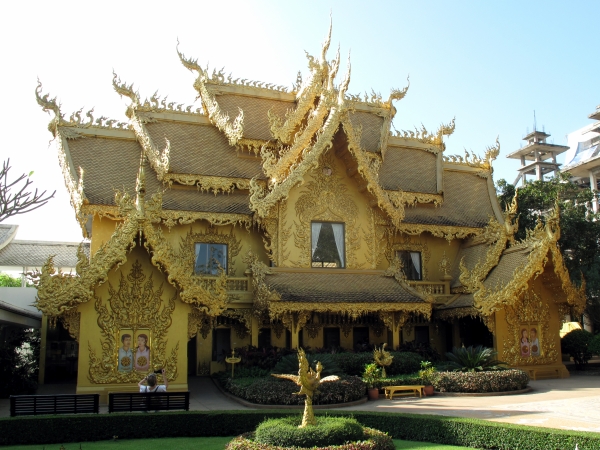My rating:
Most of the temples that tourists visit around Chiang Mai, like most of the temples that attract visitors all around Thailand, have roots going back hundreds of years, sometime to the founding of Chiang Rai more than 700 years ago. But Wat Rong Khun, which is currently one of the most popular attractions in the city, is just over ten years old.
 You 'walk through hell' to reach the main hall of the temple
You 'walk through hell' to reach the main hall of the temple
The temple was started around 1998, and only really became popular in the mid-2000s when it started to take shape. Unlike old temples, which have evolved over long periods, with contributions from many artisans, Wat Rong Khun represents the singular vision of one man, Chalermchai Kositpipat.
 The extremely delicate and ornate facade of the main prayer hall
The extremely delicate and ornate facade of the main prayer hall
The artist rose to prominence in the late 1980s, with commissions that included a Thai temple in London. His work, which blended traditional Buddhist decorative motifs with contemporary images, was controversial, especially in Thailand where rigid conformity to perceived 'tradition' is expected. However, over time his work became more accepted and he has even received commissions from the king.
 The one gold building of the complex - the toilet
The one gold building of the complex - the toilet
In 1998, Chalermchai began work on a new temple near his hometown of Chiang Rai. Like his art, the wat incorporates traditional motifs, but in a way that is completely unique. This is easily the most unusual temple in Thailand. What everyone notices, of course, is the color, or lack of it. Almost all of the temple buildings are stark white, rather than the sparkling gold and colored mirrored tiles that most every Thai temple is covered with. There are mirrored tiles on the temple, but they are used as accents, generally only consisting of a single line of silvery highlight. The intricately carved white-painted decoration demands your attention as you seek out the details.
 The well, surrounded by towers holding thousands, if not millions, of prayer chimes
The well, surrounded by towers holding thousands, if not millions, of prayer chimes
Despite being under construction for nearly 15 years (as of late 2012), the temple is still not complete. While the main buildings are more or less finished, there are more in the grand plan. A crematorium was just about ready when I visited in November 2012, while a large meeting hall was just a concrete skeleton. While work is clearly on-going, it appears it will still be many more years before it is complete.
In addition to the temple itself, there are two gallery spaces as part of the complex, one of which is devoted solely to the work of Chalermchai.
You can take it with you.
Wish you could have this information with you when you visit Chiang Rai? Now you can. Check out our ebook guides.
The temple is about 12 kilometers south of Chiang Rai, just off the main road from the city to Chiang Mai. Admission is free, although a donation would of course be welcome. This is easily one of the most popular attractions around Chiang Rai city, but the unique nature of the architecture means it's worth braving the crowds for.